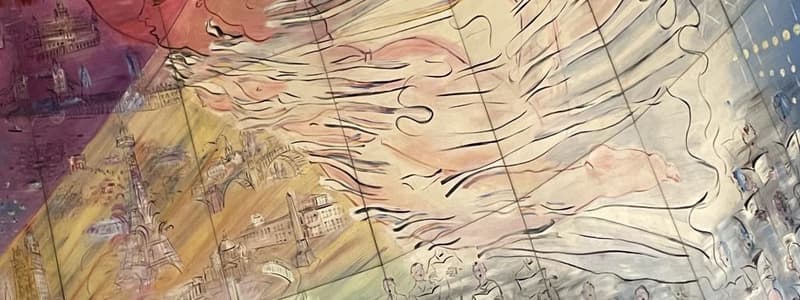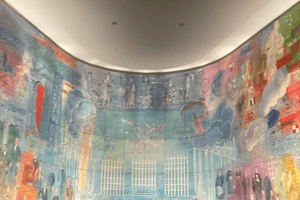Podcast
Questions and Answers
Combien mesure la fresque de la fée électricité en longueur ?
Combien mesure la fresque de la fée électricité en longueur ?
- Elle mesure 6 000m (correct)
- Elle mesure 2 500m
- Elle mesure 5 750m
- Elle mesure 1 000m
Quelle est la découverte de Marie Curie ?
Quelle est la découverte de Marie Curie ?
- Le radium (correct)
- L’Uranium
- Le Sulfur
- Iradium
Quel est le nom de la Déesse de l’Olympe présent sur la photo ?
Quel est le nom de la Déesse de l’Olympe présent sur la photo ?
- Héra (correct)
- Athéna
- Perséphone
- Athémis
Dans quelle mouvement artistique s’inscrit la fée électricité
Dans quelle mouvement artistique s’inscrit la fée électricité
Que représente cette partie de l’œuvre ?
Que représente cette partie de l’œuvre ?
Quel est le message principal de La Fée Électricité ?
Quel est le message principal de La Fée Électricité ?
Qui est ce scientifique ?
Qui est ce scientifique ?
Quelles sont les couleurs prédominantes dans cette partie de l’œuvre ?
Quelles sont les couleurs prédominantes dans cette partie de l’œuvre ?
En quelle année et où a été exposée la fresque ?
En quelle année et où a été exposée la fresque ?
Qui est l’auteur de la fresque ?
Qui est l’auteur de la fresque ?
Flashcards are hidden until you start studying
Study Notes
La Fée Électricité: A Celebration of Technological Progress
Introduction
La Fée Électricité is a monumental mural created by French artist Raoul Dufy for the 'Électricité Pavillon' at the 1937 Paris Exposition Internationale des Arts et Techniques dans la Vie moderne. This large fresco, measuring approximately 600 square meters, is a visual representation of the scientific progress in understanding and controlling electrical power. Spanning nearly two centuries, the artwork chronicles the early days of electricity, its transformation into a viable energy source, and its eventual integration into everyday life.
The History of Electrical Power
In the context of the artwork, La Fée Électricité is depicted as a series of progressive steps towards the mastery of electrical power. Starting with early observations and experiments, such as those conducted by Isaac Newton and Joseph Priestley, the piece moves on to illustrate the theoretical advancements made by scientists like James Clerk Maxwell and William Crookes. The latter half of the fresco focuses on the practical application and commercialization of electricity, with special emphasis on the role of the Royal Society and its Fellows in promoting scientific knowledge.
The Importance of the Royal Society
The presence of a group of bewigged men gathered around the title "Royal Society of London, Séance du 6 Juin 1751" is a nod to the crucial role the Royal Society played in disseminating and validating scientific discoveries. The meeting on 6 June 1751 was significant because it marked the distribution of Benjamin Franklin's work on electricity, which went on to become a landmark publication in the history of electricity and American science. This recognition of Franklin's contribution led him to receive the Copley Medal from the Royal Society in 1753 and his subsequent election as a Fellow in 1756.
La Fée Électricité and Technological Progress
As a visual representation of progress, La Fée Électricité also acts as an advertisement for the French electricity company, Compagnie Parisienne de Distribution d’Électricité, showcasing its flagship power station at Ivry-sur-Seine. The artwork has been interpreted as a celebration of technological advancements that have transformed society, such as the development of radio as the crowning achievement of electrification. Additionally, Dufy's use of luminescent colors highlights the dramatic impact of electrical power on our daily lives.
A Tribute to the Past and Future of Electrical Power
While La Fée Électricité primarily focuses on the historical aspects of electricity, Dufy also hinted at future developments. For example, he acknowledges the potential of demand-side flexibility as a fundamental aspect of energy policy, emphasizing the importance of households in managing energy supply and demand. This foreshadows the modern concept of smart grids and adaptive energy consumption, which are now integral components of renewable energy systems and sustainable living.
In conclusion, Raoul Dufy's "La Fée Électricité" serves as both a historical record of scientific progress related to electrical power and a testament to the transformative potential of technology. By highlighting key milestones in the understanding and harnessing of electricity, the artwork underscores our collective achievements while providing a glimpse into the challenges and opportunities facing us today.
Studying That Suits You
Use AI to generate personalized quizzes and flashcards to suit your learning preferences.




